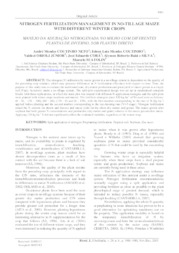Nitrogen fertilization management in no-tillage maize with different witer crops.
Nitrogen fertilization management in no-tillage maize with different witer crops.
Autoria: COUTINHO NETO, A. M.; COUTINHO, E. L. M.; ORIOLI JÚNIOR, V.; CORÁ, J. E.; SILVA, A. R. B. e; SCATOLIN, M.
Resumo: The nitrogen (N) utilization by maize grown in a no-tillage system is dependent on the quality of the preceding crop residues, which may promote differences in N fertilization efficiency with respect to time. Thus, the purpose of this study was to evaluate the nutritional state, dry matter production and grain yield of maize grown in a clayey soil (Typic Acrustox) under a no-tillage system. The split-plot experimental design was set up in randomized complete blocks with three replications, in which the main plot was treated with different N application strategies and the split-plots were planted with winter crops (soybean and maize). The fertilizer strategies (rate: 120 kg ha-1 of N) used were as follows: (0 ? 0), (20 ? 100), (60 ? 60), (120 ? 0) and (0 ? 120), with the first number corresponding to the rate of N (kg ha-1) applied before planting and the second number corresponding to the top dressing rate (V4-5 stage). Nitrogen fertilization raised the N content (in shoots and leaves) and maize yield (in the shoot dry matter and grain). The maize grown after soybean had both greater N concentrations and production (dry matter and grain) relative to the maize grown after maize. Applying 120 kg ha-1 N did not significantly affect the evaluated variables, regardless of the winter crop.
Ano de publicação: 2013
Tipo de publicação: Artigo de periódico
Unidade: Embrapa Amazônia Oriental
Palavras-chave: Adubação nitrogenada, Manejo, Milho, Plantio Direto
Observações
1 - Por padrão são exibidas publicações dos últimos 20 anos. Para encontrar publicações mais antigas, configure o filtro ano de publicação, colocando o ano a partir do qual você deseja encontrar publicações. O filtro está na coluna da esquerda na busca acima.
2 - Para ler algumas publicações da Embrapa (apenas as que estão em formato ePub), é necessário ter, no celular ou computador, um desses softwares gratuitos. Sistemas Android: Google Play Livros; IOS: iBooks; Windows e Linux: software Calibre.
Acesse outras publicações
Acesse a Base de Dados da Pesquisa Agropecuária (BDPA) para consultar o acervo completo das bibliotecas da Embrapa.

